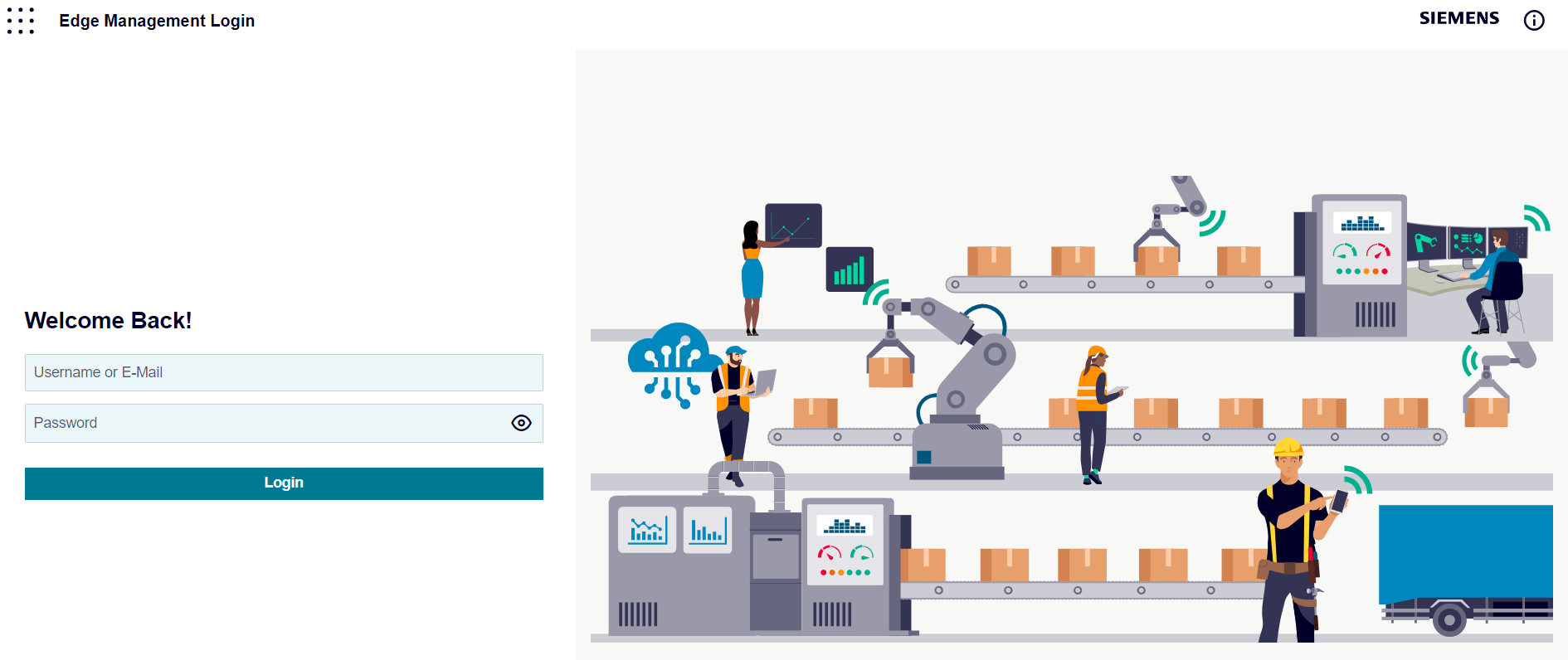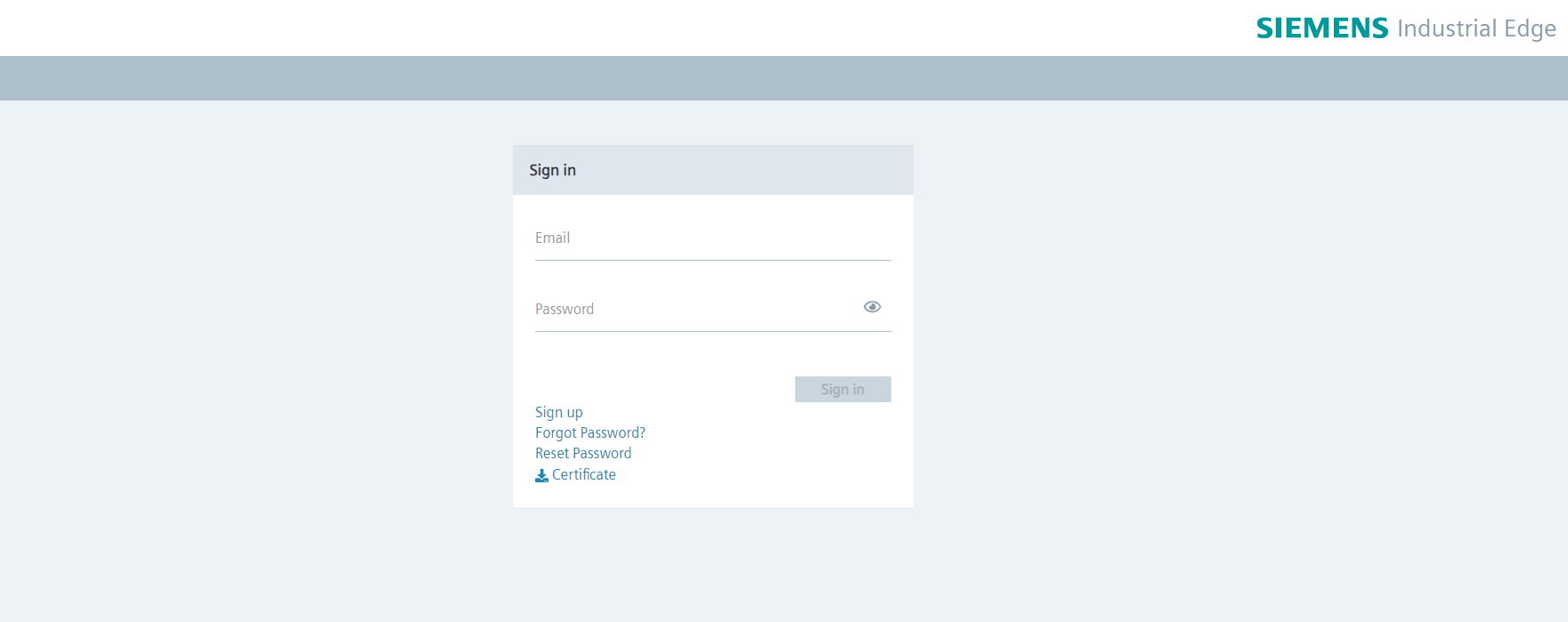Setting up IEM¶
Run the manifest file using IECTL to set up the IEM.
Also, make sure you have a CLI user available in your iehub environment. See the steps below to create one if you don't already have one.
-
Open the Industrial Edge Hub in your browser.
-
From top right menu click the API access management icon.

-
Click the
+ Grant API Accessbutton
-
Enter your details, a password will be generated, copy this password and keep it handy for future use.
Before you run the manifest file, run the following command.
export EDGE_SKIP_TLS=1
Save the manifest template as dev-setup-iem.yaml:¶
Please read the commented fields in the yaml file and update the values accordingly. Replace other variable values also with your actual credentials, IP addresses, or namespace and download locations. Make sure all values are correct and meet your requirements.
Required parameters¶
- config_url : iehub url on which iem instance will be created
- config_user : iehub cli username
- config_password : iehub cli password
- onboard_file : local path where onboarding file needs to be downloaded
- iem_namespace : use same namespace of iem which was used during kind cluster and kong cert creation
- iemuser : provide a username which will be used to login on IEM.
- iemurl : use IP address of your host machine with https protocol and port 443
- iemip : use ip address of your host machine
- iempassword : create a pssword for the IEM, please refer the rules in manifest for creating it.
- global.certchain : copy the output of
bash cat /path/to/certChain.crt | base64 -w 0and update this parameter. Also please update the path to thecertChain.crtfile before executing the command
Optional parameters¶
- config_name : iectl iehub config name
- iem_instance_name: iem instance name that will be created on iehub
variables:
config_name: "test_iehub" #update iectl iehub config name
config_url: "https://iehub.eu1.edge.siemens.cloud" #update iehub url on which iem needs to be onboarded
config_user: "user@siemens.com" #update iehub cli user
config_password: "cliuserpassword" #update iehub cli user password
onboard_file: "/Downloads/helm.json" #update local path where onboarding file needs to be downloaded
iem_instance_name: "devieminstance" #update iem instance name that will be created on iehub
iem_namespace: "deviem" #update same namespace of iem which was used during kind cluster and kong cert creation
iemuser: "iemuser@siemens.com" #update iem user email
iemurl: "https://iem-url" #update iem url
iemip: "iem-url" #update iem url
iempassword: "S@MpleP@ssw0rd" #update iem admin password, must contain at least 12 characters, one lower case, one upper chase, one special character (!@$#*&%) and one digit
commands:
- command:
target: config
resource: add.iehub
parameters:
user: "${{config_user}}"
password: "${{config_password}}"
url: "${{config_url}}"
name: "${{config_name}}"
- command:
target: iehub
resource: instance-management.create
parameters:
name: "${{iem_instance_name}}"
allowfailure: "true"
- command:
target: iehub
resource: instance-management.get-details
parameters:
name: "${{iem_instance_name}}"
filepath: "${{onboard_file}}"
- command:
target: provision
resource: install
arguments:
- ${{onboard_file}}
parameters:
namespace: "${{iem_namespace}}"
set:
- global.hostname=${{iemip}}
- global.iemAdminPassword=${{iempassword}}
- global.iamAdminPassword=${{iempassword}}
- central-auth.keycloak.initialUser.username=iemuser
- central-auth.keycloak.initialUser.email=${{iemuser}}
- global.certChain=LS0tLS1CRUdJTiBDRVJUSUZJQ0FURS0tLS0tCk1JSUdIVENDQkFXZ0F3SUJBZ0lVRHdGL3VPaTdZQ #update output of : cat /path/to/certChain.crt | base64 -w 0
- kong.deployment.hostNetwork=true
- kong.dnsPolicy=ClusterFirstWithHostNet
- kong.proxy.tls.hostPort=443
- kong.proxy.http.hostPort=80
- kong.containerSecurityContext.capabilities.add={NET_BIND_SERVICE}
- kong.containerSecurityContext.runAsGroup=0
- kong.containerSecurityContext.runAsNonRoot=false
- kong.containerSecurityContext.runAsUser=0
- kong.proxy.http.containerPort=80
- kong.proxy.tls.containerPort=443
- kong.deployment.daemonset=true
- kong.env.SSL_CERT=/etc/secrets/kongcert/tls.crt
- kong.env.SSL_CERT_KEY=/etc/secrets/kongcert/tls.key
- kong.secretVolumes.kong-proxy-tls=kongcert
- device-catalog.workflowexecutor.enabled=true
- device-catalog.firmwaremanagement.enabled=true
- command:
target: iem
resource: system.onboard-status
parameters:
url: "${{iemurl}}"
username: "${{iemuser}}"
password: "${{iempassword}}"
How to run the manifest¶
./iectl apply -f path/to/dev-setup-iem.yaml
For running the manifest in verbose mode:
./iectl apply -f path/to/dev-setup-iem.yaml --verbose
When the IEM deployment was successful, you can open the IEM Launchpad at the URL: https://<hostip>/.

Rollback IEM on Failure¶
If at any point the IEM fails to onboard, please run the following commands before re-running the IEM setup manifest.
Create a shell script with the name rollback-manifest.yaml and copy the content below.
variables:
config_name: "test_iehub" #update iectl iehub config name
config_url: "https://iehub.eu1.edge.siemens.cloud" #update iehub url on which iem needs to be onboarded
config_user: "user@siemens.com" #update iehub cli user
config_password: "cliuserpassword" #update iehub cli user password
iem_instance_name: "devieminstance" #same name which is used while setting up IEM
commands:
- command:
target: config
resource: add.iehub
parameters:
user: "${{config_user}}"
password: "${{config_password}}"
url: "${{config_url}}"
name: "${{config_name}}"
- command:
target: iehub
resource: instance-management.delete
parameters:
name: "${{iem_instance_name}}"
Create a shell script with the name rollback.sh and copy the content below.
#!/bin/bash
certkey=""
cert=""
namespace="deviem"
while getopts k:c:h:r:t:n: flag; do
case "$flag" in
k)
kindversion=${OPTARG};;
c)
kubectlversion=${OPTARG};;
h)
helmversion=${OPTARG};;
r)
certkey=${OPTARG};;
t)
cert=${OPTARG};;
n)
namespace=${OPTARG};;
esac
done
iectl apply -f rollback-manifest.yaml --verbose
kubectl delete namespace $namespace
kubectl create namespace $namespace
kubectl -n $namespace create secret tls kongcert --key $certkey --cert $cert
After the above step is completed, run the script with the following command
NOTICE
Please update the value of the iem namespace variable -n before running. Use the same iem namespace that was created during cluster setup.
bash +x rollback.sh -r "out/myCert.key" -t "out/myCert.crt" -n "deviem"
Setup IED¶
Run the manifest file using IECTL to set up the IED.
Before executing the manifest file, please run the command below. Also make sure to have a CLI user ready on your iehub environment.
export EDGE_SKIP_TLS=1
Save the manifest template as dev-setup-ied.yaml:¶
Please read the commented fields in the yaml file and update the values accordingly. Replace other variable values also with your actual credentials, IP addresses, or namespace and download locations. Make sure all values are correct and meet your requirements.
Required parameters¶
- config_url : iehub url from which ied kit will be donwloaded
- config_user : iehub cli username
- config_password : iehub cli password
- iemuser : iem username which was created in iem manifest
- iemurl : iem url https://
<hostip>:443 - iempassword : iem password which was created in iem manifest
- ieduser : provide a username to login on IED
- iedurl : https://
<hostip>:9445 - iedpassword : create a pssword for the IED, please refer the rules in manifest for creating it.
- macAddress : mac address of VM on which ied is setup by using command :
ip addr show - devicetypeID : please update the variable devicetypeID in the below yaml based on device types available on IEM. To check available device types use command iectl iem device-types.
- download_path : update download path where ied kit artifact will be downloaded from IEHUB
Optional parameters¶
- config_name : iectl iehub config name
variables:
config_name: "test_iehub" #update iectl iehub config name
config_url: "https://iehub.eu1.edge.siemens.cloud" #update iehub url from which ied kit will be downloaded
config_user: "user@siemens.com" #update iehub cli user
config_password: "cliuserpassword" #update iehub cli user password
iemuser: "iemuser@siemens.com" #update iem user email
iemurl: "https://iem-url" #update iem url
iempassword: "S@MpleP@ssw0rd" #update iem admin password, must contain at least 12 characters, one lower case, one upper chase, one special character (!@$#*&%) and one digit
ieduser: "ieduser@siemens.com" #update ied user email
iedurl: "https://ied-url:9445" #update ied url with port 9445
iedpassword: "S@MpleP@ssw0rd" #update iem admin password, must contain at least 12 characters, one lower case, one upper chase, one special character (!@$#*&%) and one digit
macAddress: "00:00:11:ab:00:11" # update the host machine mac address
devicetypeID: "core.ieipc" #check if device type exists on IEM
download_path: "/Downloads/" #update download path where ied artifact will be downloaded from IEHUB
commands:
- command:
target: config
resource: add.iehub
parameters:
user: "${{config_user}}"
password: "${{config_password}}"
url: "${{config_url}}"
name: "${{config_name}}"
- command:
target: config
resource: add.iem
parameters:
name: "iem_config"
url: "${{iemurl}}"
user: "${{iemuser}}"
password: "${{iempassword}}"
- command:
target: iem
resource: system.onboard-status
parameters:
url: "${{iemurl}}"
username: "${{iemuser}}"
password: "${{iempassword}}"
- command:
target: iehub
resource: run-ied-dev
parameters:
name: "Industrial Edge Device Kit - x86-64"
path: "${{download_path}}"
- command:
target: iem
resource: device.onboard
parameters:
id: "${{devicetypeID}}"
url: "${{iedurl}}"
name: "ied_dev"
username: "${{ieduser}}"
password: "${{iedpassword}}"
allowfailure: "true"
nics: '{"MacAddress":"${{macAddress}}","GatewayInterface":true,"DHCP":"enabled","Static":{"IPv4":"","NetMask":"","Gateway":""}}' #mac address of VM on which ied is setup by using : ip addr show
Running the manifest¶
./iectl apply -f path/to/dev-setup-ied.yaml
for running the manifest in verbose mode
./iectl apply -f path/to/dev-setup-ied.yaml --verbose
When the IED deployment was successful, the IED can be opened at the URL: https://<hostip>:9445/.

Important checkpoints¶
- Please change the iem instance name before running the manifest again.
- Only one IEM instance can be mapped to a namespace. If the namespace is created and manifest fails in between, please delete the cluster and follow the process to create a new cluster and namespace and update the manifest with new values.
- The IEDK will be created on port "9445". Update the IED url with port as well.
- To find the VM's Mac address, run the
ifconfigcommand in a terminal.
Deleting Cluster¶
To delete the clusteruse the command:
kind delete cluster
To delete the IED use the command:
docker ps #to check ied container id
docker rm -f < Container_ID>
docker rmi -f <ied image name>